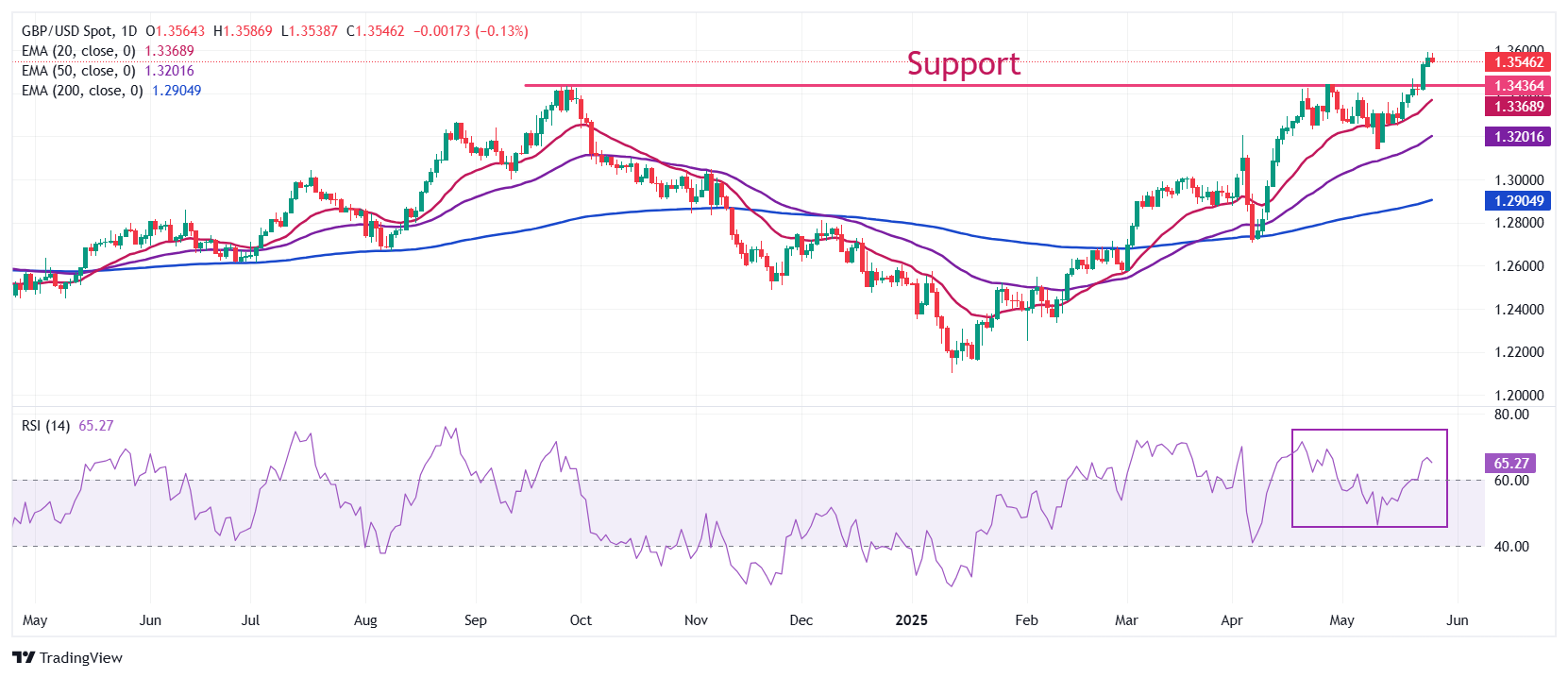Pound Sterling corrects against US Dollar, while US tariff uncertainty still persists
- The Pound Sterling corrects to 1.3550 against the US Dollar amid uncertainty over the US economic outlook.
- Fed’s Kashkari warns of stagflation risks under the leadership of US President Trump.
- Traders pare BoE dovish bets on a slew of positive UK economic data.
The Pound Sterling (GBP) retraces to near 1.3550 against the US Dollar (USD) in Tuesday’s European session from the three-year high around 1.3600 posted the previous day. The GBP/USD pair ticks lower, while the outlook of the US Dollar is still fragile as investors struggle to predict how bilateral deals by the United States (US) with its trading partners will shape its economic outlook.
At the time of writing, the US Dollar Index (DXY), which tracks the Greenback’s value against six major currencies, jumps to near 99.35 after attracting bids near the monthly low of 98.70.
Federal Reserve (Fed) officials have predicted that new economic policies by US President Donald Trump will prompt stagflation risks in the economy, and any monetary policy adjustment would be inappropriate until the scale of increase in inflation and weakness in economic growth can be anticipated.
On Monday, Minneapolis Federal Reserve President Neel Kashkari affirmed, “There’s no question that the shock of tariffs is stagflationary”. “Uncertainty is something that is top of the mind for the Fed and US businesses, and we’re trying to navigate where inflation and the labor market are going,” Kashkari added.
Another reason behind weakness in the US Dollar is uncertainty over Washington’s trade discussions with Japan, China, and the European Union (EU). Over the weekend, US President Trump extended the deadline for 50% tariffs on the EU to July 9 from June 1 after European Commission President Ursula von der Leyen assured that the continent will advance trade negotiations quickly and urged for some time to reach a good deal.
On the economic front, investors await the US Durable Goods Orders data for April, which will be published at 12:30 GMT. The cost of fresh orders for Durable Goods is expected to have declined by 7.9% after a robust increase of 9.2% in March.
Daily digest market movers: Pound Sterling outperforms its peers
- The Pound Sterling reflects some strength against most of its major peers on Tuesday as traders become increasingly confident that the monetary expansion cycle by the Bank of England (BoE) would be moderate than what the central bank guided in its policy announcement earlier this month.
- According to a report from Reuters, the futures market shows traders see borrowing rates falling by around 38 basis points (bps) by the end of this year, indicating one 25 bps interest rate cut and a roughly 50% odds of a second.
- Major triggers behind the increase in traders’ confidence towards a moderate policy-easing stance are robust United Kingdom (UK) Q1 Gross Domestic Product (GDP) growth, hotter-than-projected Consumer Price Index (CPI), and upbeat Retail Sales data for April.
- This month, the Office for National Statistics (ONS) reported that the economy grew at a robust pace of 0.7% in the first quarter of the year, the headline CPI accelerated at a faster pace to 3.5% on year, and the Retail Sales expanded strongly by 1.2% on month.
- In the policy meeting earlier this month, the BoE reduced borrowing rates by 25 bps to 4.25% with a 7-2 vote split and guided a “gradual and careful” interest rate cut approach. BoE Chief Economist Huw Pill was one of the two policymakers who voted for leaving interest rates at their current levels. Pill expressed confidence in a speech at Barclays in London last week that the “underlying disinflation process remains intact”. His vote in favor of holding interest rates steady was to indicate that the central bank needs to be cautious on rate cuts. “Quarterly pace of 25 bps cuts seen since last summer is too rapid given the inflation outlook,” Pill said and added, “Pace of quarterly cuts too rapid given the balance of risks to price stability we face.”
Technical Analysis: Pound Sterling retraces to near 1.3550

The Pound Sterling corrects to 1.3550 against the US Dollar on Tuesday after hitting a fresh three-year high the previous day. The near-term trend of the GBP/USD pair remains bullish as all short-to-long term Exponential Moving Averages (EMAs) are sloping higher.
The 14-day Relative Strength Index (RSI) rises to near 70.00, indicating a strong bullish momentum.
On the upside, the January 13, 2022, high of 1.3750 will be a key hurdle for the pair. Looking down, the April 28 high of 1.3445 will act as a major support area.
Pound Sterling FAQs
The Pound Sterling (GBP) is the oldest currency in the world (886 AD) and the official currency of the United Kingdom. It is the fourth most traded unit for foreign exchange (FX) in the world, accounting for 12% of all transactions, averaging $630 billion a day, according to 2022 data. Its key trading pairs are GBP/USD, also known as ‘Cable’, which accounts for 11% of FX, GBP/JPY, or the ‘Dragon’ as it is known by traders (3%), and EUR/GBP (2%). The Pound Sterling is issued by the Bank of England (BoE).
The single most important factor influencing the value of the Pound Sterling is monetary policy decided by the Bank of England. The BoE bases its decisions on whether it has achieved its primary goal of “price stability” – a steady inflation rate of around 2%. Its primary tool for achieving this is the adjustment of interest rates. When inflation is too high, the BoE will try to rein it in by raising interest rates, making it more expensive for people and businesses to access credit. This is generally positive for GBP, as higher interest rates make the UK a more attractive place for global investors to park their money. When inflation falls too low it is a sign economic growth is slowing. In this scenario, the BoE will consider lowering interest rates to cheapen credit so businesses will borrow more to invest in growth-generating projects.
Data releases gauge the health of the economy and can impact the value of the Pound Sterling. Indicators such as GDP, Manufacturing and Services PMIs, and employment can all influence the direction of the GBP. A strong economy is good for Sterling. Not only does it attract more foreign investment but it may encourage the BoE to put up interest rates, which will directly strengthen GBP. Otherwise, if economic data is weak, the Pound Sterling is likely to fall.
Another significant data release for the Pound Sterling is the Trade Balance. This indicator measures the difference between what a country earns from its exports and what it spends on imports over a given period. If a country produces highly sought-after exports, its currency will benefit purely from the extra demand created from foreign buyers seeking to purchase these goods. Therefore, a positive net Trade Balance strengthens a currency and vice versa for a negative balance.

